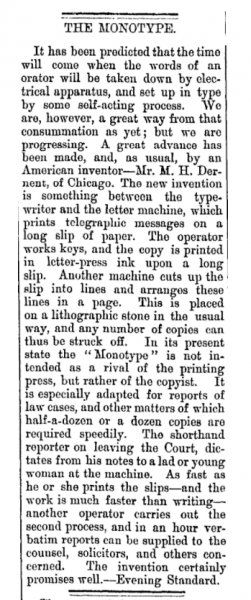The Other “Monotype”?
Can any one shed any light on this story? It’s from a New Zealand newspaper, June 1885, two years before the Lanston Monotype Machine Company was formed.

Screen Shot 2017-05-14 at 9.13.32 AM.png
ffi |
fl |
5m |
4m |
’ |
k |
e |
1 |
2 |
3 |
4 |
5 |
6 |
7 |
8 |
$ |
@ |
# |
Æ |
Π|
æ |
œ |
|||||
j |
b |
c |
d |
i |
s |
f |
g |
ff |
9 |
A |
B |
C |
D |
E |
F |
G |
||||||||||
? |
fi |
0 |
||||||||||||||||||||||||
H |
I |
K |
L |
M |
N |
O |
||||||||||||||||||||
Can any one shed any light on this story? It’s from a New Zealand newspaper, June 1885, two years before the Lanston Monotype Machine Company was formed.

Screen Shot 2017-05-14 at 9.13.32 AM.png
This process was mentioned in the documentary, Linotype: The Film, in describing the history of the invention of typesetting machines. You will find this film very informative on things other than just the Linotype.
I think the term “Monotype” was used by the reporter of the newspaper article in a generic sense.
Complete and probably, red herring, bum Steer, load of c***, etc., but is it just possible that it is/was stenography by another name, from the Ex Court reference(s)
Silly thought, apologies if so . Mick.
Not stenography Mick, but a viable alternative to Lanston’s system, although it was developed for lithography rather than letterpress. The system might have been taken further if Lanston’s machine hadn’t thwarted Dement’s ambitions.
I wrote a lengthy piece for “Small Printer” on this process some time ago. It worked, and pre-dated Tolbert Lanston’s invention, although the single typeface available was unattractive and the letter/word spacing was “leggy”. Like Lanston’s machine, it was a 2-part system, with a strip composer and text “paste-up” device.
Dement’s machine utilised a rapidly spinning cylinder containing engraved steel characters. Alphanumeric keys were struck, actuating hammers which pressed the revolving letters (which were inked with lithographic ink) onto a tickertape. The system worked, although the traditional lithographic process meant that adhesives could not be used to stick the “cut-and-paste” masters to the printing surface. They were clamped into place on a special litho plate.
The ‘Other’ Monotype (and yes, Monotype WAS its formal trade name) was used to print several issues of a Monotype Company magazine in London (a single surviving copy is held at St Bride library in London). Perhaps significantly, the masthead and colophon were set in conventional hand-set types. Dement’s machine was slow, labour-intensive, and produced slurred, leggy text. With sufficient investment it might have been developed into a litho composer which worked, but the system fell by the wayside, overtaken by Lanston’s letterpress system.
I’ll find some images and post them later.
Here are some images of Mr Dement’s Monotype and its output.
MonotypeBriar.JPG
Bob, Thank You so much, for the above, terrific reading for the >Old Goat< down in Sussex.
One little side issue, in an informative way only, always believed that Monotype V Linotype was just (basically) a 2 horse race between Tolbert & Ottmar, seems as though Your Mr. Dement might have been an outsider or a late starter, maybe a Precursor even.?
One more prompted by Your *spinning cylinder* etc. perhaps *DYMO* tape printers were not that original, MAYBE, Pictorial Machinery,s photo lettering machine, was also not that new.?
****
From vague memory, Pictorial Machinery was a sub division of Monotype, operating from Crawley but had a Sub Assembly plant in Brighton, Studio Lettering machines from revolving disc, probably linked to Oliver Burridge also in Crawley.
Please correct Me if I be wrong.
Thanks Again. Mick.